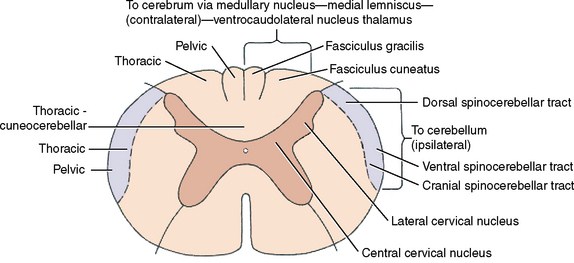
These are deep-seated receptors present in the muscles, tendons and joints. These receptors are:
- Muscle Spindle or Neuromuscular Spindle: These sensory end organs are present in muscles.
- Golgi Tendon Organ or Neurotendinous Spindle: The receptors are present in tendons.
- Proprioception sensation is also carried from joint structures like: Capsule, ligaments and synovial membrane. These receptors are Pacinian corpuscles which have been already discussed.
Neuromuscular spindle
Neuromuscular spindles are also known as muscle spindles. These are sensory end organs present in voluntary muscles. They are more abundant in number in the muscle close to its junction with tendons. These receptors, on stimulation, send information to the central nervous system regarding state of contractionand position of voluntary muscles. Central nervous system uses this information for control of activity of voluntary muscles.
Neuromuscular spindle is a fusiform or spindleshaped organ whose long-axis is parallel to the length of a muscle. Length of this end organ varies from 1–4 mm. It is enclosed by a connective tissue capsule. Inside the capsule of this fusiform organ, units of this sensory receptors are situated. These are specialized muscle fibers called intrafusal fibers. In contrast to these intrafusal fibers (inside the spindle), usual muscle fibers (myocytes) of voluntary muscle, outside the spindle, are called extrafusal fibers which are effector in nature. The intrafusal fibers of neuromuscular spindle are of following two types:
- Nuclear bag fibers.
- Nuclear chain fibers.
Both these types of fibers are specialized muscle fibers. Their long-axis are parallel to the length of the spindle. Their number in a spindle varies from 6–14.
Each of them presents a central part (equatorial part) and two terminal ends. Fundamentally terminal ends of both these fibers present transverse striations of voluntary muscles and are contractile in nature. Central or equatorial part lacks striation property and present accumulation of many nuclei.
Nuclear bag fibers: Equatorial part of these fibers presents spherical sac which is filled up with nuclei. Length of nuclear bag fiber is more. Their ends project beyond the capsule and are fixed through their attachment to connective tissue of extrafusal fibers.
Nuclear chain fibers: Structurally these differ from nuclear bag fibers. These are shorter in lengthand uniform in breath althrough. But the equatorial part presents collection of nuclei in the form of rows or chains.
Both intrafusal fibers are receptor as well as effector organs – It is important to notice at this stage that, though the neuromuscular spindle are proprioceptive sensory end organs, intrafusal fibers inside the spindle act as both receptor as well as effector. Equatorial or central noncontractile part acts as receptors and terminal cross striated, contractile parts act as effectors, which receive sensory and motor nerve fibers respectively.
Mode of function of neuromuscular spindle: It is understood that central (equatorial) nonstriated as well as noncontractile part of both nuclear bag and nuclear chain type intrafusal fibers are receptor of voluntary muscle. From receptors proprioceptive sensations are carried by sensory root of spinal nerves to the spinal cord. The terminal contractile parts of both type of intrafusal fibers receive efferent (motor) nerves which are axons of small-sized (less than 25 microns) gamma motor neurons of gray mattter of spinal cord. Again extrafusal fibers, lying outside neuromuscular spindle, are supplied by axons of large sized (more than 25 microns) alpha motor neurons of spinal cord gray matter.
It is very important as well as interesting to note at this stage that functions of the neuromuscular spindle proprioceptors is interrelated to the function of contractile terminal parts of intrafusal fibers supplied by gamma motor neurons as well as function of extrafusal fibers supplied by alpha motor neurons.
Even when a muscle is in a resting stage, in unnoticed (subconscious) state of an individual, motor impulse is carried from higher centers of brain, e.g. basal ganglion, cerebellum, reticular formations to the gamma motor neurons of spinal cord through descending motor fiber tracts. Impulse pass via axons of gamma neurons to both the contractile ends of intrafusal fibers. When both the ends are contracted, central noncontractile receptor part (proprioceptor) gets stretched and so stimulated.
Sensory impulse is carried from here through afferent (sensory) roots of spinal nerve to the gray matter of spinal cord where it forms synapse with alpha motor neurons. Stimulation of alpha neurons helps to keep the extrafusal fibers so the whole voluntary muscle in a partially contracted stage (in resting condition) which maintains thus the tone
Source: Easy and Interesting Approach to Human Neuroanatomy (Clinically Oriented) (2014)